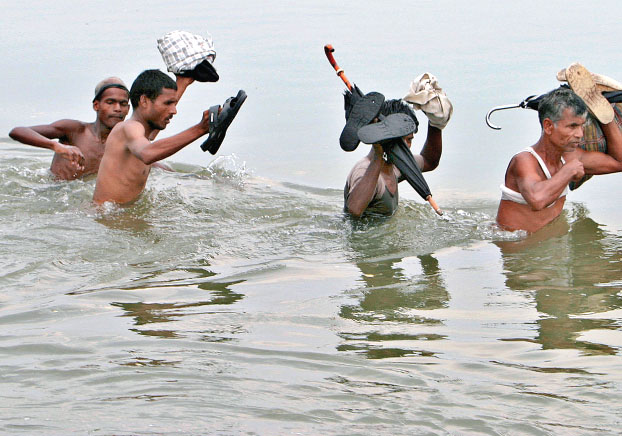Swings of Climate Worrying the World?
 Majority of meteorological scientists believe that this time India may face the problem of scant rainfall, which may affect June to September (Kharif) crops such as rice, cotton, maize, tur, urad, pulses, oilseeds etc. Initial apprehensions about monsoons were based on data released by international agencies and private forecasters; however now even Indian Meteorology Department (IMD) has also released the similar forecast and stated that there was a 56% probability of below normal to deficient rains, as compared to a 44% chance of rains being normal or better. The department said there was a 60% chance of an El Nino. In fact, IMD has merely ratified the statistics of other agencies.
Majority of meteorological scientists believe that this time India may face the problem of scant rainfall, which may affect June to September (Kharif) crops such as rice, cotton, maize, tur, urad, pulses, oilseeds etc. Initial apprehensions about monsoons were based on data released by international agencies and private forecasters; however now even Indian Meteorology Department (IMD) has also released the similar forecast and stated that there was a 56% probability of below normal to deficient rains, as compared to a 44% chance of rains being normal or better. The department said there was a 60% chance of an El Nino. In fact, IMD has merely ratified the statistics of other agencies.
Research by Stanford University:According to a recent research by Stanford University, a change in the of wet and drey spells has been noticed in monsoon, which can lead to accute drought and flood situation in India. During critical crop growth stages, too many days without rain can reduce yields or lead to crop failure, which can reverberate through India”s agriculture-dependent economy. At the same time, short periods of very heavy rainfall can create humanitarian disasters, such as in 2005. The team compared rainfall data gathered by the Indian Meteorological Department and other sources over a 60-year period. The researchers used rigorous statistical methods to compare peak monsoon rainfall patterns during two time periods from 1951 to 1980 and from 1981 to 2011. The team looked specifically at rainfall during the months of July and August, which is the peak of the South Asian summer monsoon.? |
Nobody can predict future with perfection, however, if past had any guide, we can say that behaviour of rains around the globe has been closely linked to “El Nino” effect. US weather experts are expressing the possibility of heavy rainfall this year. Skymet, a private sector Indian company in weather forecast sector, has said that there is 40% likelihood that this year India may face the problem of lower than normal monsoon. The company said that they are looking at the possibility of El Nino this year and year 2014 may be El Nino year. The company has said that with time passing by, the possibility of El Nino is becoming stronger. National Oceanic and Atmospheric Administration of USA has said that possibility of El Nino is 50 percent, while Australia”s Meteorological Bureau has predicted 70 percent possibility of El Nino.
What is El Nino?
El Nino is a band of anomalously warm ocean water temperatures that periodically develops off the Pacific coast of South America. It is apprehended that parts of USA may experience heavy rainfall and winter may be even colder. As per the metrological data available as on April 9, 2014, expectations of Al Nino have increased to 66 percent; up from 52 percent, last month. Nobody can say with certainty about the exact impact of El Nino on weather and rainfall; however it is almost certain that southern parts of USA, from Texas to Florida and many other places will experience more than average rainfall, on the other hand effect would be almost opposite on India and other Asian countries.
Impact of El Nino on India
There is a theory that after a gap of three to seven year, a season comes when there is an unusual warming of the ocean surface around equatorial Pacific. This phenomenon is often associated with bad southwest monsoons in India. It is possible that there may be acute drought or below average rainfall; however in any case there could be acute adverse impact on agriculture. It is notable that in India, crops raised between June and September, are heavily dependent on monsoon. Economists believe that if monsoon fails partially, food products may become costlier, making the life difficult for the common man.
In India, there has been a strong correlation between monsoon and agricultural production. If we look at the data for the preceding eight years we find that since 2005-06, food grain production has increased from 208.6 million tons to 263 million tons in 2013-14. However, if we see El Nino years; or years of monsoon failures, we find failure of food crops as well. For instance year 2008 was the year of failure of Monsoon, and our food grain production declined and the nation was forced to import wheat to supplement its stocks. However, due to good monsoons in the years of 2010-11, 2011-12 and 2013-14 we find good food grain production of 259.3, 255.4 and 263 million tonnes respectively.
However, during these years due to reason other than agriculture, our growth rate has been declining. Growth which had reached 8.8 percent in 2010-11 came down to 6.2% in 2011-12, 4.5% in 2012-13 and for 2013-14, it is not going to exceed 5 percent (may remain nearly 4.8%). Expecting a recovery, Asian Development Bank and some other agencies have pegged the growth rate for 2014-15 at more than five percent; however definitely they have not taken into account, the latest forecasts of El Nino or expected failure of monsoon. It is notable that due to good monsoon in the last more than three years, we had experienced good food production; however if monsoon fails in 2014, it is definitely going to impact food prices, especially grains, fruits and vegetables. If past is any guide, we find inflation causes interest rates to go up. Nation has been passing through a tough phase of hyper inflation and constantly rising interest rates in the recent past. After every quarter, we expect from RBI that it would bring the interest rates down, however every time inflation data forbids RBI to reduce interest rates. In the event of loss to agro sector, due to El Nino, GDP growth may get hurt.
Preparations Needed
Today government is struggling to maintain sufficient food stock to fulfill its commitment to implement Food Security Act. As per the Act, the government is committed to provide 5 Kilogram food grain per person to nearly 65 percent of population, which cannot be avoided. However if monsoon fails this Kharif season, government may face a hill task to provide food grains as per the Act. We must understand that no single country or even the whole globe has the capacity to feed this nation. Today, big grain producing countries like US, are keen on growing bio-fuel crops. They are converting their food grain stocks into ethanol, to fulfill their energy needs. Even, Food and Agriculture Organisation (FAO) of UN has expressed concerns for the same.
It is observed that whenever there is shortfall in production, the nation is forced to import food grains, which sends the prices of food products sky rocketing. Therefore El Nino may further the inflationary tendencies. Government should enhance its procurement efforts and top up its stocks. Government may give special attention for novel methods of irrigation for Kharif crops, including encouragement to drip irrigation. Banks and financial institutions should also be ready with their contingency plans.
-Dr Ashwani Mahajan(The writer is an Associate Professor of PGDAV College, University of Delhi)?














Comments